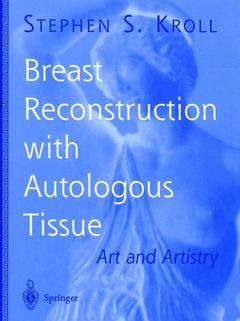Description
Breast Reconstruction with Autologous Tissue, 2000
Art and Artistry
Author: Kroll Stephen S.
Language: English
Subject for Breast Reconstruction with Autologous Tissue:
Keywords
care; complication; complications; fat; implant; reconstruction; surgery; tissue
Approximative price 52.74 €
In Print (Delivery period: 15 days).
Add to cart
Publication date: 04-2013
376 p. · 21x27.9 cm · Paperback
376 p. · 21x27.9 cm · Paperback
Description
/li>Contents
/li>
Discussing the most current and pioneering techniques in breast reconstruction without the use of implants, this is the volume every breast surgeon has been waiting for. Focusing not only on how to reconstruct breasts following mastectomy but also on how to achieve the highest degree of aesthetic success possible, Dr. Kroll describes in detail his techniques in using autologous tissue. Over 500 photographs and custom illustrations demonstrate and compare the different techniques used in breast reconstruction with autologous tissue such as conventional TRAM flaps, free TRAM flaps, the extended latissimus dorsi myocutaneous flap, and the Rubens fat pad free flap. Also include are chapters on immediate and delayed reconstructions, shaping the breast mound, nipple and areolar reconstruction and choice of technique, follow-up and patient selection.
Goals of Breast Reconstruction.- Why Autologous Tissue?.- Why Use Free Flaps?.- Immediate Breast Reconstruction.- Delayed Breast Reconstruction.- Bilateral Breast Reconstruction.- Choice of Technique.- Conventional (Pedicled) TRAM Flap.- Free TRAM Flap.- Deep Inferior Epigastric Perforator Flap.- TRAM Flap Postoperative Care and Complications.- The Extended Latissimus Dorsi Myocutaneous Flap.- The Superior Gluteal Free Flap.- The Inferior Gluteal Free Flap.- The Rubens Fat Pad Free Flap.- Shaping the Breast Mound in Immediate Reconstruction.- Shaping the Breast Mound in Delayed Reconstruction.- Shaping the Breast Mounds in Bilateral TRAM Flap Breast Reconstruction.- Correction of Partial Mastectomy Defects.- Breast Mound Revision Surgery.- The Opposite Breast.- Nipple and Areolar Reconstruction.- Follow-Up of TRAM Flap Breast Reconstruction Patients.
© 2024 LAVOISIER S.A.S.




